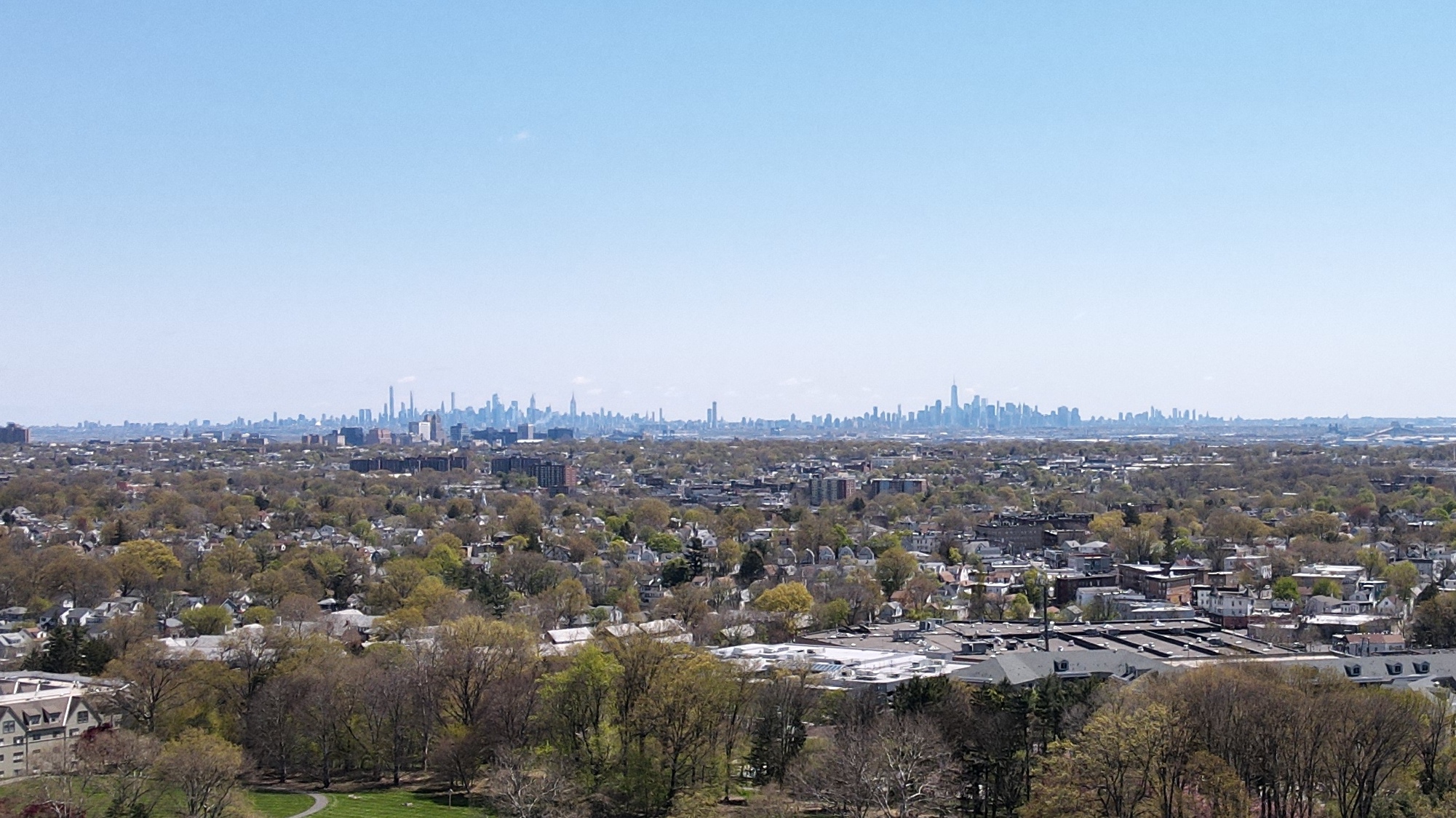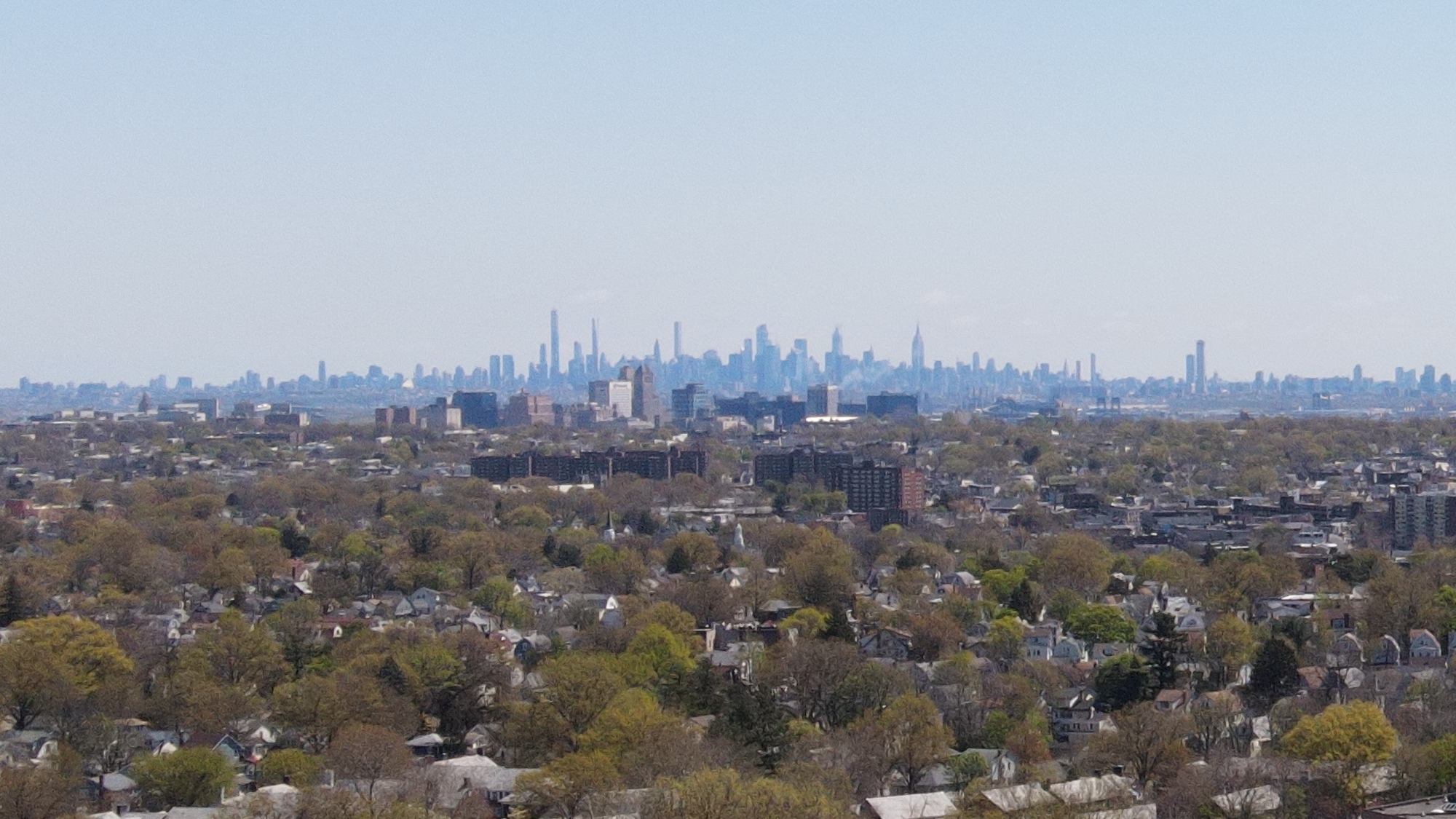Tom's Guide Verdict
Get the DJI Mavic Air 2 if you want a drone that can take 4K video for less than $1,000.
Pros
- +
Fast, nimble flier
- +
Great battery life
- +
Comfortable controller
- +
Excellent photos and video
Cons
- -
Drab design compared to previous model
Why you can trust Tom's Guide
Size (folded): 7.1 x 3.8 x 3.3 inches
Size (unfolded): 9.96 x 7.2 x 3 inches
Weight: 570 grams (1.25 pounds)
Max video resolution: 4K/60 fps
Photo sensor: 1/2 inch, 12MP
Flight time: 34 minutes
FAA registration: Required
The DJI Mavic Air was a pretty impressive drone: It folded up into a compact shape, was a cinch to fly, and took pretty awesome 4K video, all for less than $1,000.
Its successor is even better. The DJI Mavic Air 2 can shoot 4K video at up to 60 frames per second, and has a number of new tricks, like 240fps slo-mo video and the ability to take 48MP still images. Additionally, the Mavic Air 2 has improved motion-tracking, so it can stay locked on a subject, even if they momentarily disappear from the camera's sight. And, with a 34-minute flight time, you'll be able to stay aloft for even longer. Best of all, the Mavic Air 2 costs $799.
Check out the rest of our DJI Mavic Air 2 review to see why it's one of the best drones around.
DJI Mavic Air 2: Price and Availability
The Mavic Air 2 is available in two configurations: A standard package which includes the drone, one battery, and the remote control costs $799. The Fly More combo, which includes everything from the standard package, plus a shoulder bag, ND filters, charging hub, and three batteries costs $988.
For something cheaper, check out our DJI Mini 2 review.
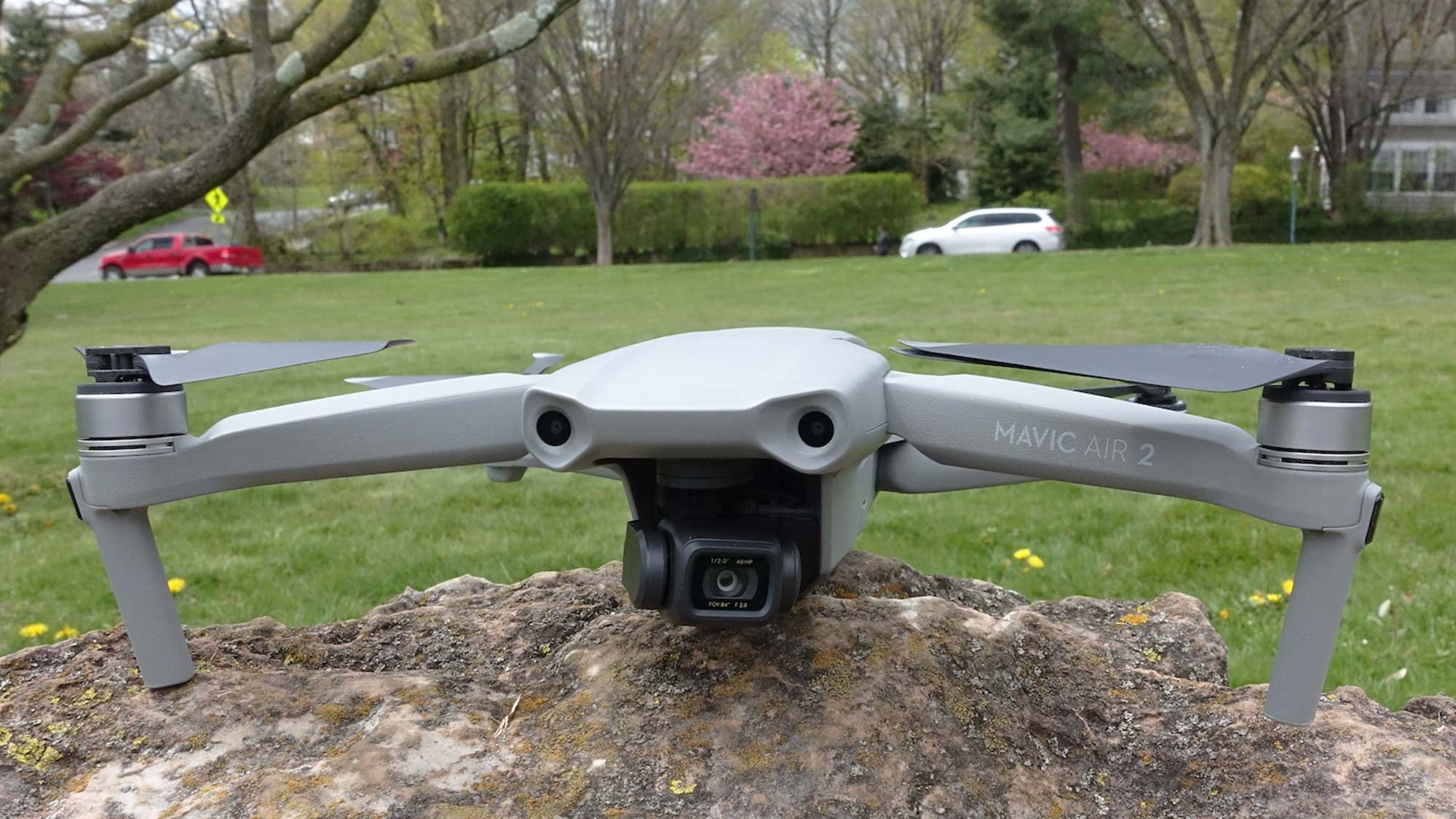
DJI Mavic Air 2: Design
When holding the Mavic Air 2 in one hand and the Mavic Mini in the other, the Mini felt positively toylike compared to the much larger, and much heavier Mavic Air 2. Both drones look alike — a similar shade of gray, as well as DJI’s now-signature folding-arm design — but the Mavic Air 2 is much more substantial.

The Mavic Air 2 looks much more like the Mavic 2 Pro (and the Mavic Mini) than the original Mavic Air, for better and worse. While this now unifies the design language of the Mavic line, the all-gray Mavic Air 2 is less exciting visually, and less sleek than the original Mavic Air, which had a smoother top, and was a blend of black, white, and silver. The dull gray of the Mavic Air 2 also makes it much harder to see while flying, especially on overcast days.
Get instant access to breaking news, the hottest reviews, great deals and helpful tips.
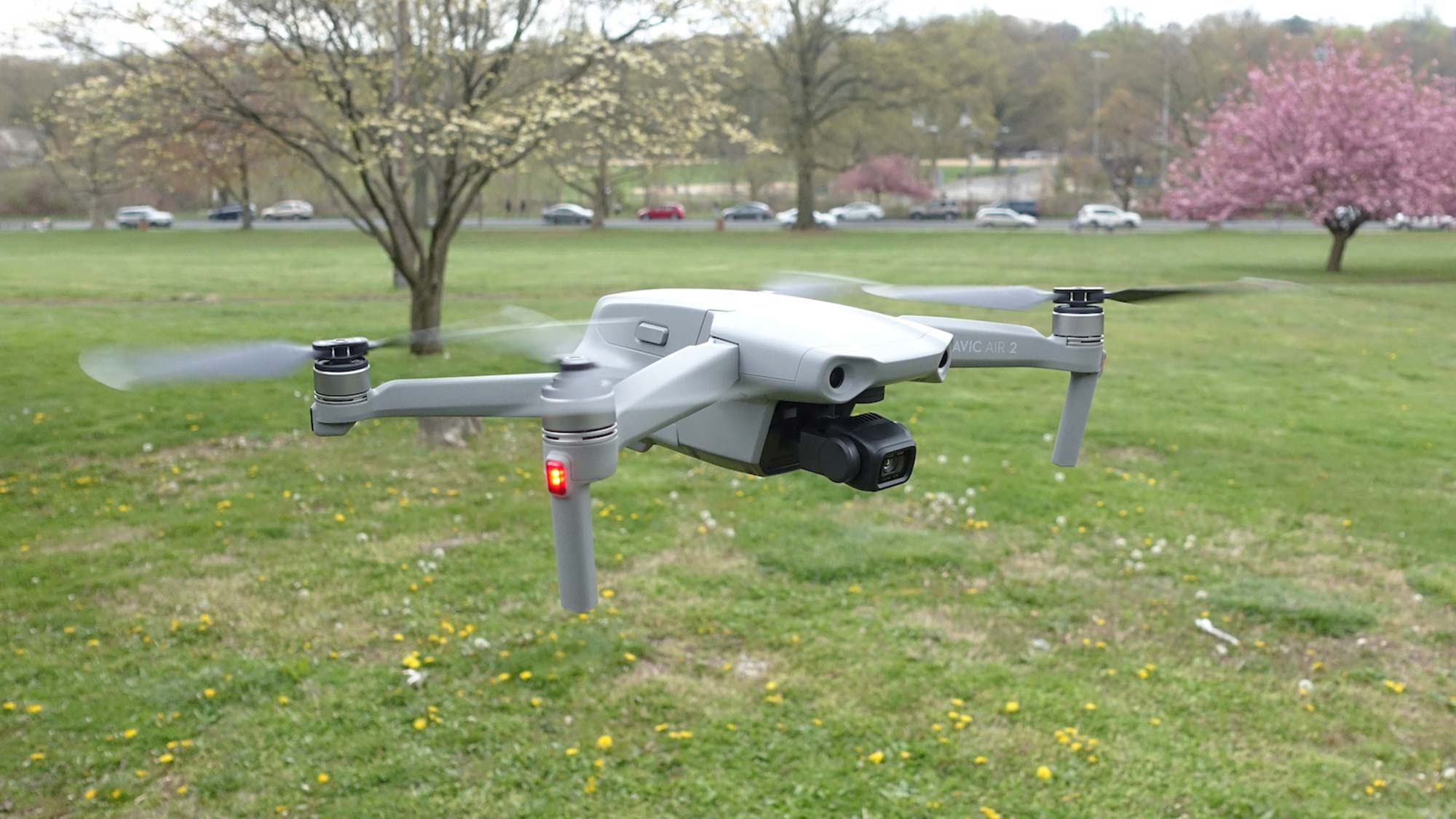
Weighing 570 grams (1.25 pounds), the Mavic Air 2 is more than twice the weight of the Mini (249 grams/8.8 ounces), as well as the Mavic Air (430 grams). The Air 2’s weight is higher than the limit imposed by the FAA, so this is a drone you’ll have to register.
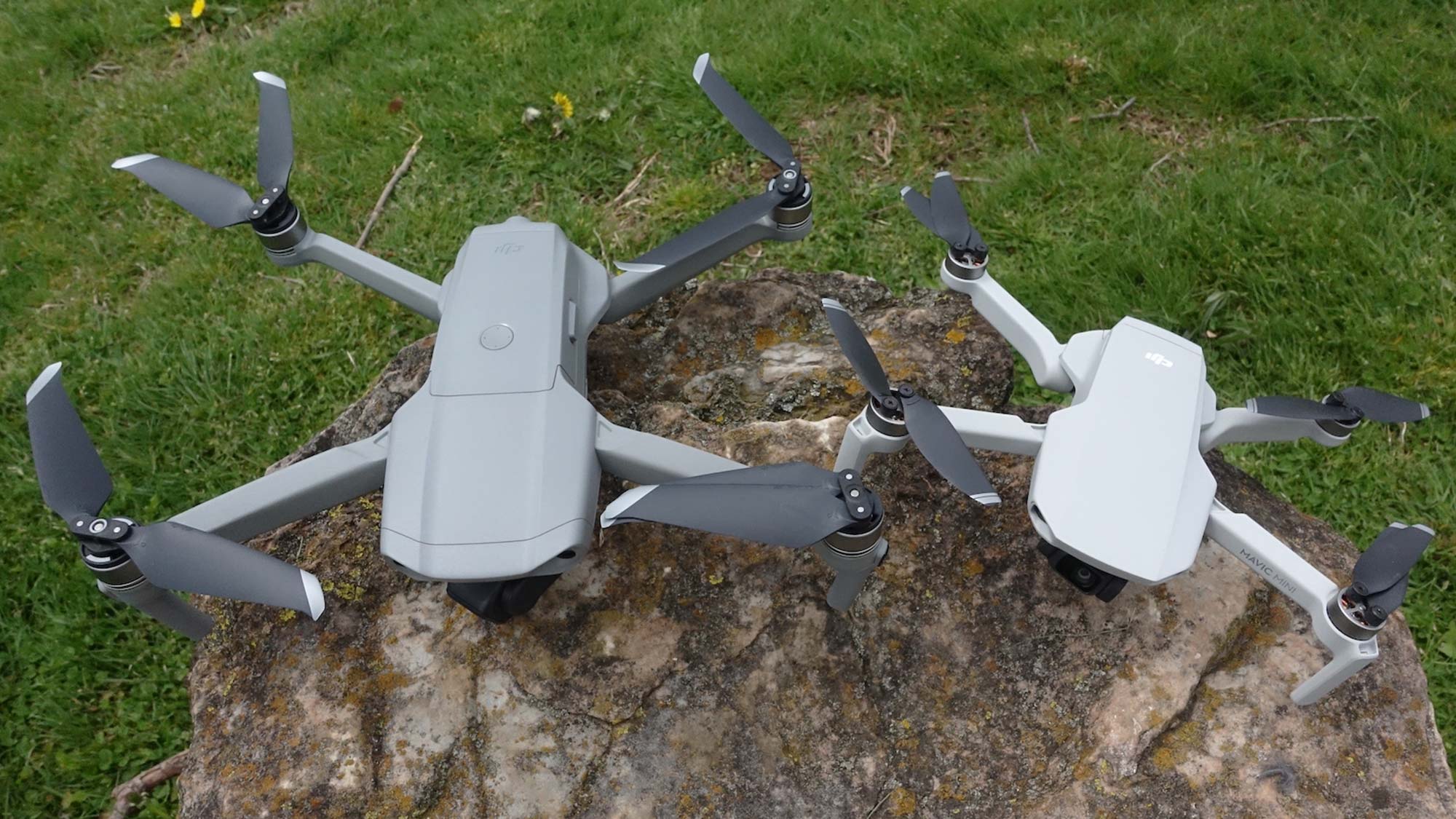
Similar to the Mavic Air, the Mavic Air 2 has sensors on the front, bottom, and rear to help it avoid objects. (The Mini only has sensors on the front and bottom). In addition, the Air 2 has the latest version of DJI’s obstacle-avoidance system, Advanced Pilot Assistance System (APAS) 3.0. When enabled, APAS will plot a course around any object that comes into the flight path of the drone. However, this is only available when shooting video up to 4K/30 fps; APAS turns off automatically at higher framerates.
Additionally, the Mavic Air 2 is the first of DJI’s drones that can receive ADS-B signals from piloted aircraft, and show their location on the controller screen. This feature, called AirSense, will only be initially available in North America, due to the coronavirus; a version of the Mavic Air 2 without AirSense will be sold in all other regions, but a version with AirSense will be available globally by this summer.
DJI Mavic Air 2: Controller
The biggest difference that you’ll notice at first glance between the Mavic Air 2 and its predecessor involves the controller, which is completely redesigned. It’s now much more substantial, almost twice the size as previous DJI controllers. Instead of two downward-folding arms, which cradled your smartphone between your palms, the controller now has a spring-loaded bracket that extends upward from the top.
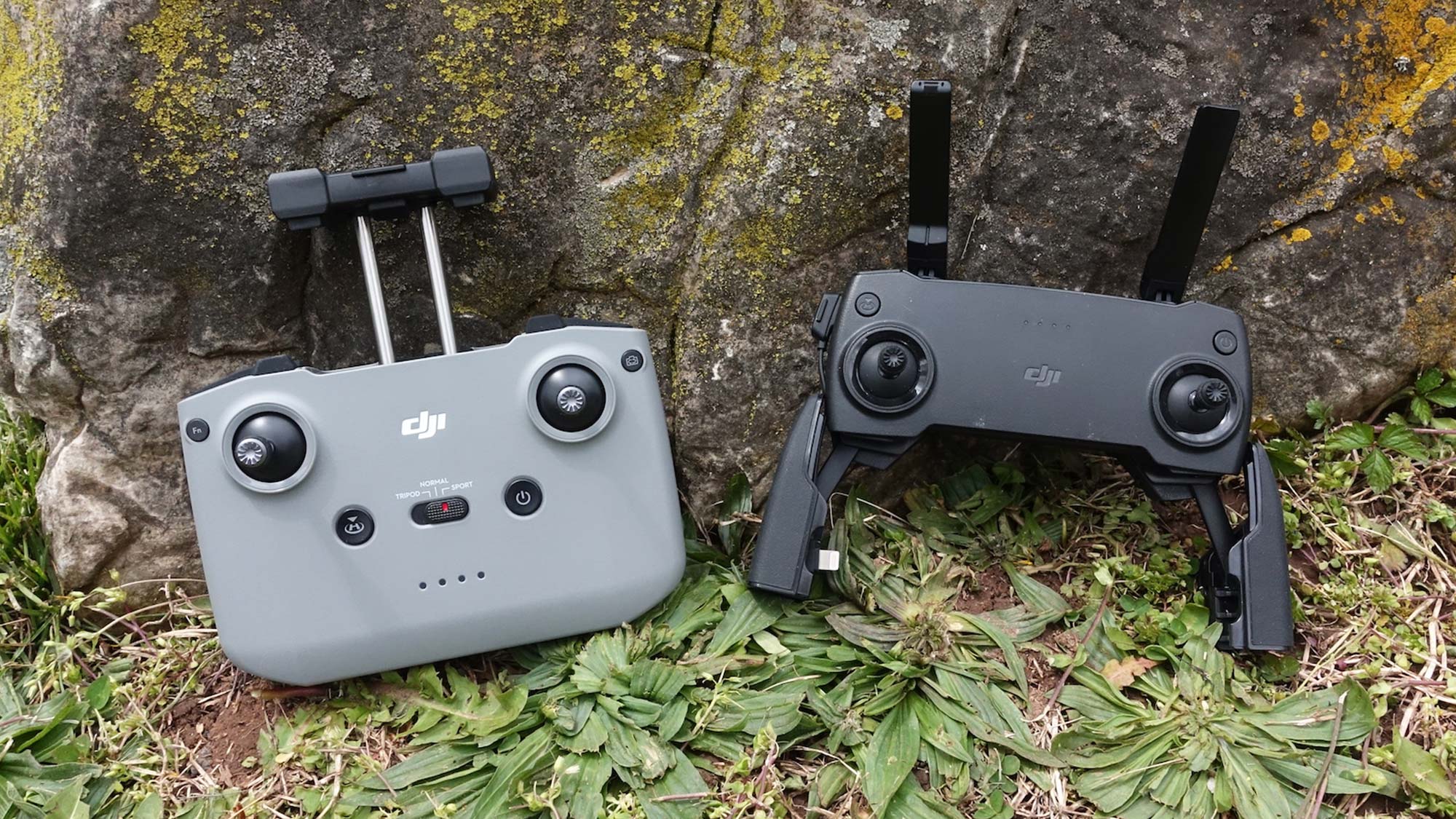
One thing I like about the new controller is that connecting it to my iPhone is less fussy; before, I always fumbled when threading the USB-to-Lightning wire through the controller’s arm.
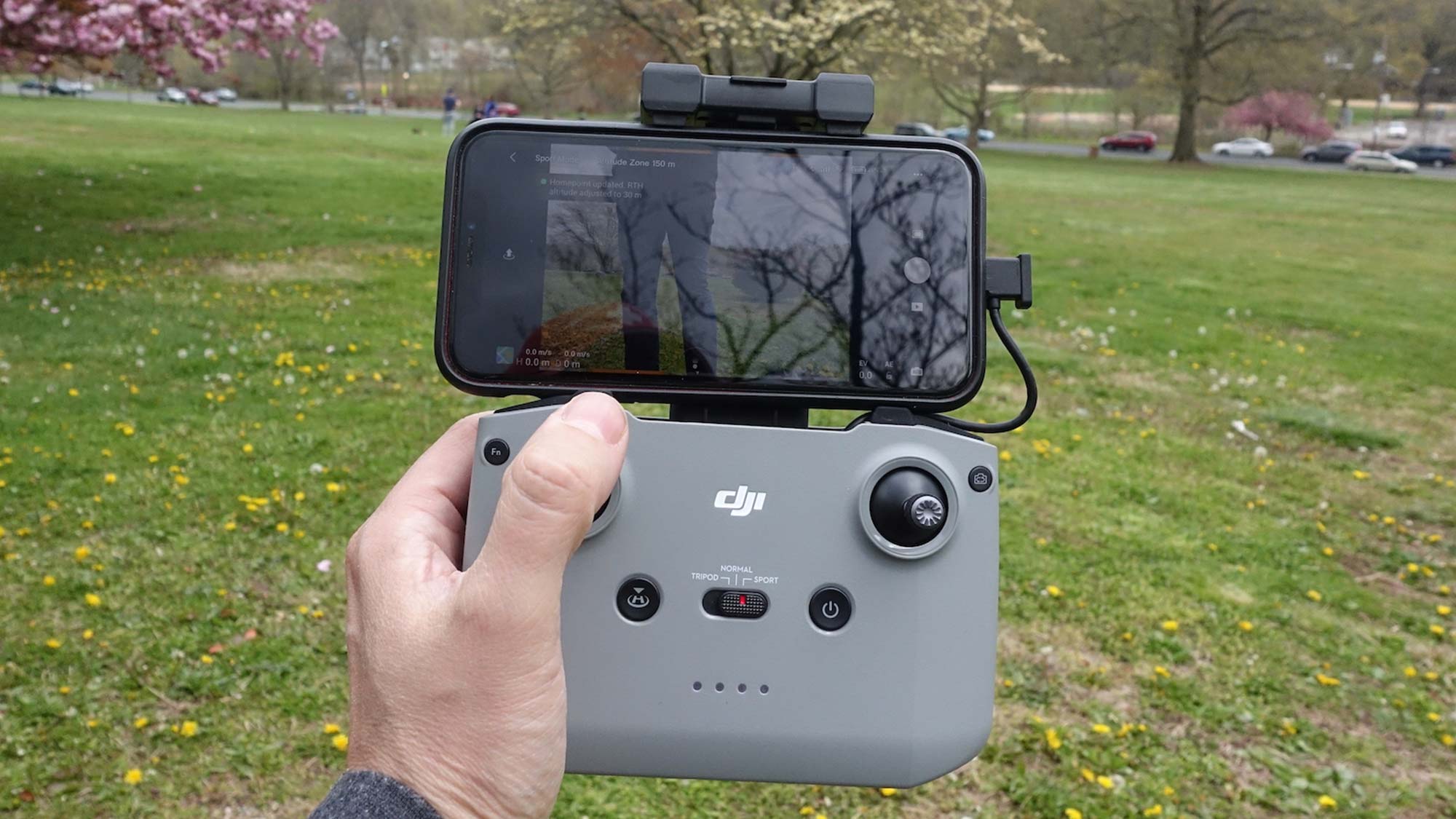
As before, the controller has two control sticks, which unscrew so you can stow them in the bottom of the controller. Because the remote is so much larger, it looks much more spartan than DJI’s other controllers, even though it has a few more buttons.
At first, I thought I wouldn’t like the larger, heavier controller, but as I flew the Air 2 around, I liked having my iPhone’s display above the joysticks, rather than below. It felt more natural in that position.
The controller also has an improved 10km transmission range, so you can feasibly fly the drone up to six miles away, and still get a clear picture on your smartphone’s display. Of course, you should only fly a drone where you can still see it, but it’s a pretty impressive range. While the Mavic Air never went more than 400 feet away from me, I never noticed any interference or interruption of the feed from the camera.
DJI Mavic Air 2: Camera features
While it has the same 12MP resolution as the Air, the Mavic Air 2 has a larger 1/2-inch image sensor (versus 1/2.3-inch sensor on the Air).
Additionally, the Mavic Air 2 can take high-resolution 48MP photos using a Quad Bayer sensor and a technique called pixel binning. In the few photos I was able to take, this feature seemed to work well; I was able to blow up a photo of an ornamental cherry tree much larger than a similar photo taken under the Air 2’s normal camera settings.
However, there’s a limit to its effectiveness: When I blew up a photo of Manhattan (taken from 15 miles away) to full size, the city’s skyline was mottled, and lacked detail.
I’m also looking forward to testing out Hyperlight, a new feature where the Air 2 takes multiple low-light photos, and merges them into one, brighter image. This feature wasn’t available during my time with the drone, but will be available at launch.
Another feature aimed at helping photographers is SmartPhoto; the Mavic Air 2 will be able to recognize five categories of scenes — such as sunsets, blue skies, grass, snow, and trees — and optimize the camera settings accordingly.
Similar to previous models, the Mavic Air 2 can take HDR photos, but the Air 2 takes a series of seven photos to blend together, versus three for the original Air.
DJI Mavic Air 2: Video features
The Mavic Air 2 can record video up to 4K at 60 frames per second, twice that of the Air, which maxed out at 4K/30 fps. It can also record 4X and 8X slow-motion video, as well as 1080p video at 240 fps. The Air 2 can also capture HDR video, but the max resolution for this mode is 4K/30fps.
As with other DJI drones, I marveled at the stability of the video footage I shot using the Mavic Air 2; it was as smooth and stable as if I had the drone mounted on a tripod. The blossoms of cherry trees were lush and pink, and the grass beneath was as verdant as the spring day. The drone did a pretty good job of adjusting the exposure as I panned the camera from the darker ground to the brighter, overcast sky.
On a sunnier day, video was exceptional. The pink flowers on a tree were bright and colorful, details in surrounding houses were crisp, and the skyline of New York stood out sharply against the blue sky.
But beyond pure specs, DJI has added a passel of new and updated features designed to make your aerial footage more cinematic.
ActiveTrack 3.0 lets you select a subject, and the Mavic Air 2 will automatically follow it. This newest version is supposed to not just follow a subject better, but avoid objects and re-lock on the subject if it temporarily moves behind an object.
This feature worked creepily well; I selected myself on the DJI app's screen, and the Mavic Air 2 started following me around a field like something out of a sci-fi film. Not only did it avoid and evade trees in its path, but it was able to maintain a lock on me even after I ducked behind a trunk. This only works so well; if you remain hidden for more than a few seconds, the drone loses its lock.
Point of Interest 3.0 lets you create an automated flight path around an object, and Spotlight 2.0, which has been a feature in DJI’s Inspire drones, will lock onto a subject and keep it in frame as the drone operator pilots the drone.
Also coming soon is 8K Hyperlapse. Available as a firmware update in mid-May, this will let you take high-resolution time-lapse videos — well, as much as the Mavic Air 2’s battery allows.
DJI Mavic Air 2: Battery Life
DJI claims the Mavic Air 2’s flight time is 34 minutes under ideal conditions; that’s 14 minutes longer than the Mavic Air, and a few minutes longer than the Mavic Mini.
The first flight I took with the Air 2, its battery lasted at least 22 minutes, based on the timestamps of my photos and videos. This flight consisted of a good deal of hovering (which drains the battery faster) as I took pictures of the drone for this review. A subsequent flight, which also involved plenty of hovering, lasted at least 25 minutes. I plan to update this section as I take the drone on more flights.
As with its other drones, you can swap out the Mavic Air 2’s battery; It takes roughly 1 hour and 40 minutes to recharge. Extra batteries will cost $115 each.
DJI Mavic Air 2: Verdict
There’s no question that the Mavic Air 2 is a great drone. As with DJI’s other products, it flies like a champ, has amazing battery life, and comes with a host of excellent features for taking aerial photos and video.
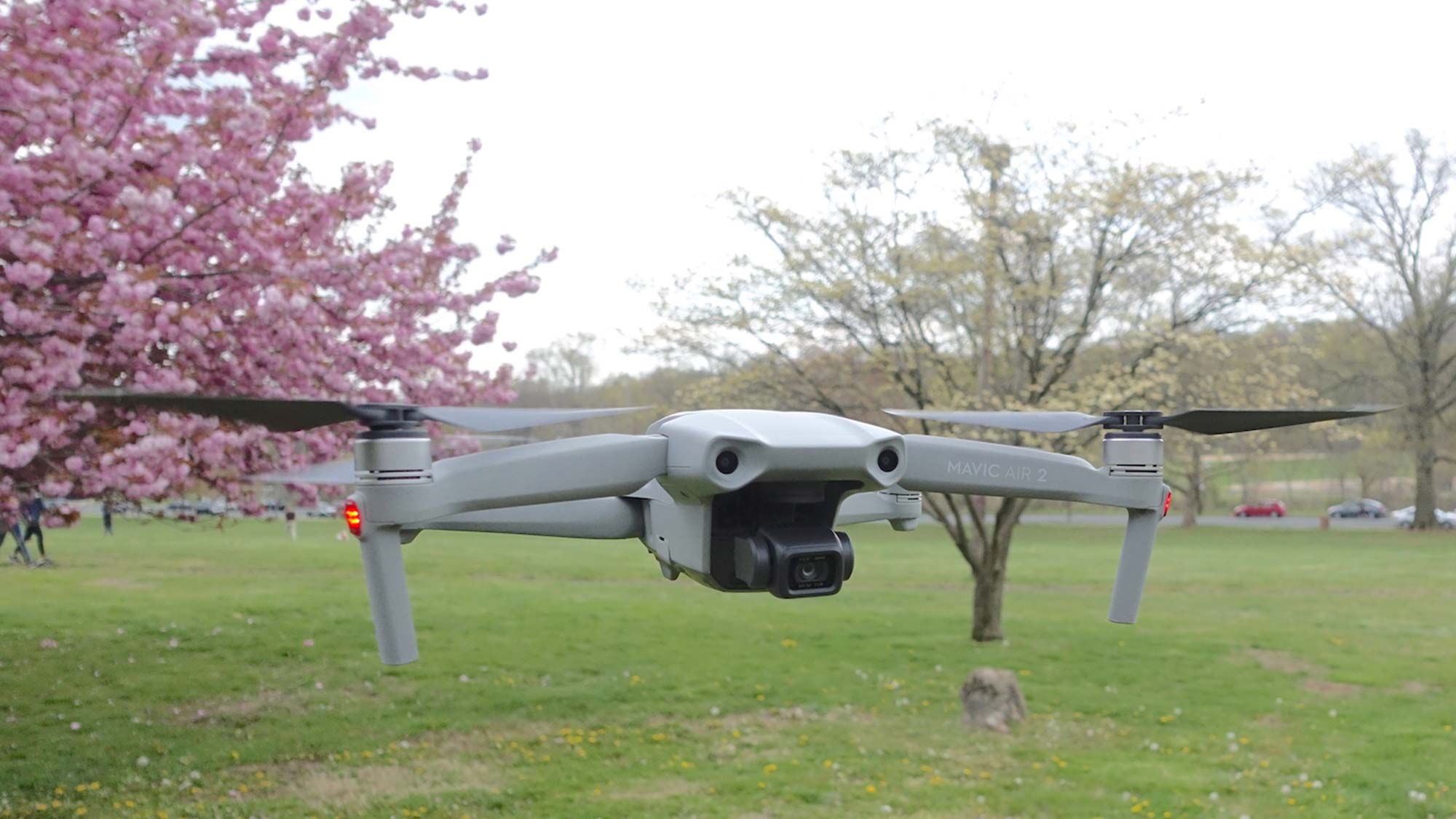
At $799, the Mavic Air 2 strikes a good balance of features vs. price. While it’s more than twice as expensive as the Mavic Mini, it’s about $500 less than the Mavic 2 Zoom, and half the price of the Mavic 2 Pro. In some ways, the Mavic Air 2 is even better than the Mavic 2 Zoom, which has a smaller 1/2.3 image sensor than the Air 2, and which can only shoot video at a max resolution of 4K/30 fps. (Of course, the Mavic 2 Zoom has a 2x zoom lens, which lends itself to some neat video tricks.)
I still think the DJI Mavic Mini is the best drone for most people, as its small size and low price make it more accessible for the masses, but the DJI Mavic Air 2 is the best drone for those who don't want to spend more than $1,000, but want to capture stunning video.

Michael A. Prospero is the U.S. Editor-in-Chief for Tom’s Guide. He oversees all evergreen content and oversees the Homes, Smart Home, and Fitness/Wearables categories for the site. In his spare time, he also tests out the latest drones, electric scooters, and smart home gadgets, such as video doorbells. Before his tenure at Tom's Guide, he was the Reviews Editor for Laptop Magazine, a reporter at Fast Company, the Times of Trenton, and, many eons back, an intern at George magazine. He received his undergraduate degree from Boston College, where he worked on the campus newspaper The Heights, and then attended the Columbia University school of Journalism. When he’s not testing out the latest running watch, electric scooter, or skiing or training for a marathon, he’s probably using the latest sous vide machine, smoker, or pizza oven, to the delight — or chagrin — of his family.



